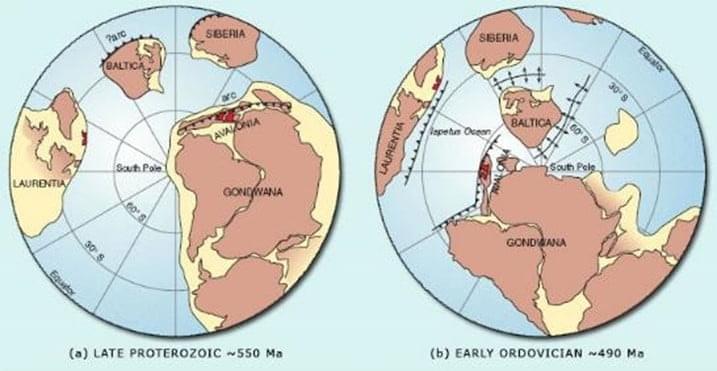700 Million Years Ago
Saolú Aigéin – An Ré Neoprótarasóch
Our geological story starts 700 million years ago in the Neoproterozoic Era, the final part of the Precambrian. At this time, there was one supercontinent in the southern hemisphere that we now call Rhodinia. The only parts of Ireland that were part of this continent were the island of Inishtrahull off of Co Donegal, part of the Mullet Peninsula in Co Mayo and the area south of Bray, including the Sugarloaf, in Co Wicklow.


Thosaigh an oll-ilchríoch Róidinia ag scoilteadh óna chéile (i.e. osclaíodh scoilteán go mall agus roinneadh an ilchríoch ina codanna) agus thosaigh aigéan nua darb ainm Iaipéiteas ag oscailt thar ar 590 milliún bliain ó shin. De réir mar a lean an dá bhloc ilchríche ag bogadh óna chéile, bhrúcht magma chun urlár nua aigéin a chruthú agus sil-leagadh dríodair amhail láib, gaineamh, agus gairbhéal agus cruthaíodh aolchloch.
We see rocks of this age in Ireland in both the southeast in Co Wicklow and Co Wexford and in the northwest in Connemara, North Co Mayo, Co Sligo, Co Tyrone, Co Donegal and Co Antrim. The rocks to the southeast are associated with a vast continent we call Gondwana and the rocks to the northwest are associated with a continent we call Laurentia.
Laurentia includes parts of Scotland, Greenland, and Eastern Canada whereas Gondwana includes parts of southern Britain and the eastern edge of North America and the whole of Africa, South America and Antartica.
In the Joyce Country and Western Lakes geopark region, we see evidence of rocks of this age from Corr na Móna westwards and from Cur Hill in the Maam valley to south of Maam Cross. Our internationally famous rock, Connemara Marble, started off as limestone at the centre of the new ocean floor. The soft Lakes Marble Formation of the Maam valley was once limestone and sand found in the shallow waters of the young Iapetus Ocean, and the tops of the Maamturks and the Twelve Bens were once sand from the continent deposited on this ocean floor.